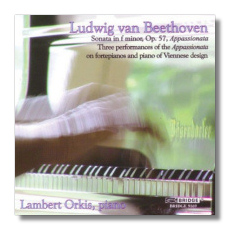
The Internet's Premier Classical Music Source
Related Links
- Beethoven Reviews
- Latest Reviews
- More Reviews
-
By Composer
-
Collections
DVD & Blu-ray
Books
Concert Reviews
Articles/Interviews
Software
Audio
Search Amazon
Recommended Links
Site News
 CD Review
CD Review
Ludwig van Beethoven

Piano Sonata #23 in F minor, Op. 57 "Appassionata"
Lambert Orkis, piano & fortepianos (three performances)
Bridge 9169 DDD 76:25
This fascinating CD lets us compare performances of the same Beethoven sonata on three different pianos. The first is a fortepiano built in 1990 by Thomas and Barbara Wolf, but inspired by instruments constructed by Nanette Streicher in the latter portion of the 1810s. The second is a modern Bösendorfer Imperial Concert Grand. The third is another fortepiano, built in 2000 by R.J. Regier, but inspired by several instruments built in Vienna around 1830 by the Graf and Bösendorfer firms. (For the sake of brevity, I will refer to these three instruments as the Wolf, the Bösendorfer, and the Regier.)
Beethoven wrote the "Appassionata" in 1805. As Lambert Orkis explains in his extensive booklet notes, the Wolf is the one instrument among the three used here which most closely resembles those in use at the beginning of the 1800s. Piano technology was growing by leaps and bounds during this era, however, and Beethoven kept abreast of it. For example, the "Hammerklavier" Sonata was inspired, at least in part, by a six-octave piano sent to the composer as a gift in 1818 by the English manufacturer Broadwood. These three performances, then, present the "Appassionata" as it might have been heard at the time of its composition, shortly after Beethoven's death, and as we hear it today on a modern instrument which, for many listeners, is most appropriate for Beethoven's music. No one is suggesting that any one of these performances is more "correct" than the others. The purpose of this recording is to enlighten, not to dictate.
The differences in timbre among these instruments are accounted for by their size, the materials used, and the ways in which these materials were assembled. The pedals in particular make a great deal of difference. The Wolf and Regier fortepianos have pedal systems which differ greatly from those found on modern pianos, and quite unusual effects can be achieved through their judicious use. Timbral differences among the three instruments also are accounted for by the subtle differences among the manners in which a pianist is compelled to play these instruments. For example, on the Wolf, the black keys are narrower than on a modern piano, and the white keys are shorter. These are not trivial considerations, as a pianist moves from instrument to instrument. As a pianist's technique changes, so does his or her sound.
Orkis is a fabulous pianist, and he is the master of all three instruments. Regardless of the instrument, he plays the sonata with straightforward authority and without interpretive exaggerations. Between the two fortepianos, I like the Regier better. Its slightly metallic timbre is more expressive than the Wolf's, and its action is quieter too. At first, one notices the relative strangeness of the Wolf's and the Regier's timbres, but one tends to forget about it anyway as the music sweeps on. Surely that's a testimony not only to Orkis' playing, but also to the craftsmanship of Thomas and Barbara Wolf, and of R.J. Regier.
This recording was made in 2003. Apparently all three pianos were recorded in the same venue over a three-day period, which was sensible, given the excellent idea behind this CD. Now, it would be wonderful if Orkis recorded all 32 sonatas on period instruments!
Copyright © 2006, Raymond Tuttle




















